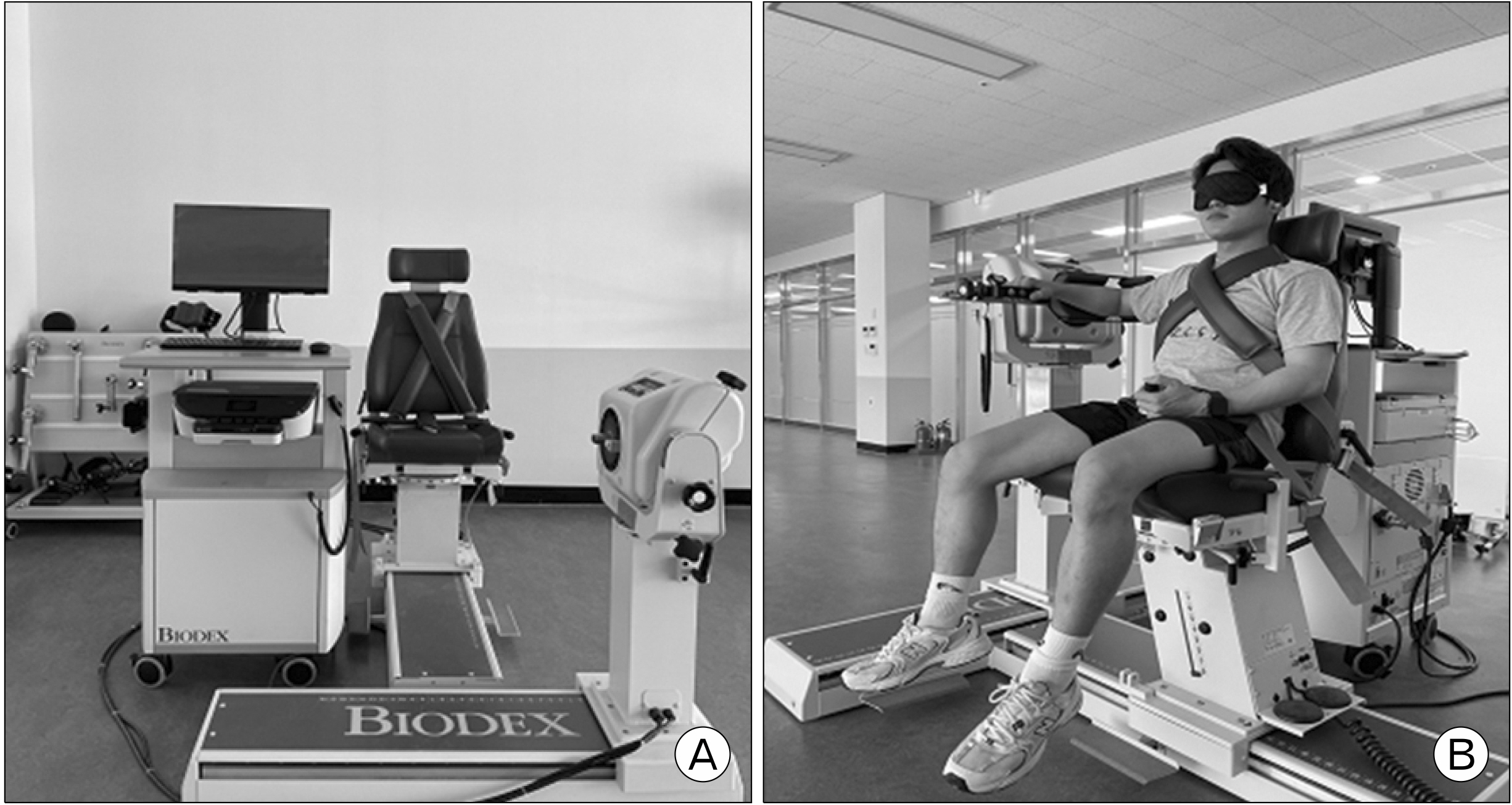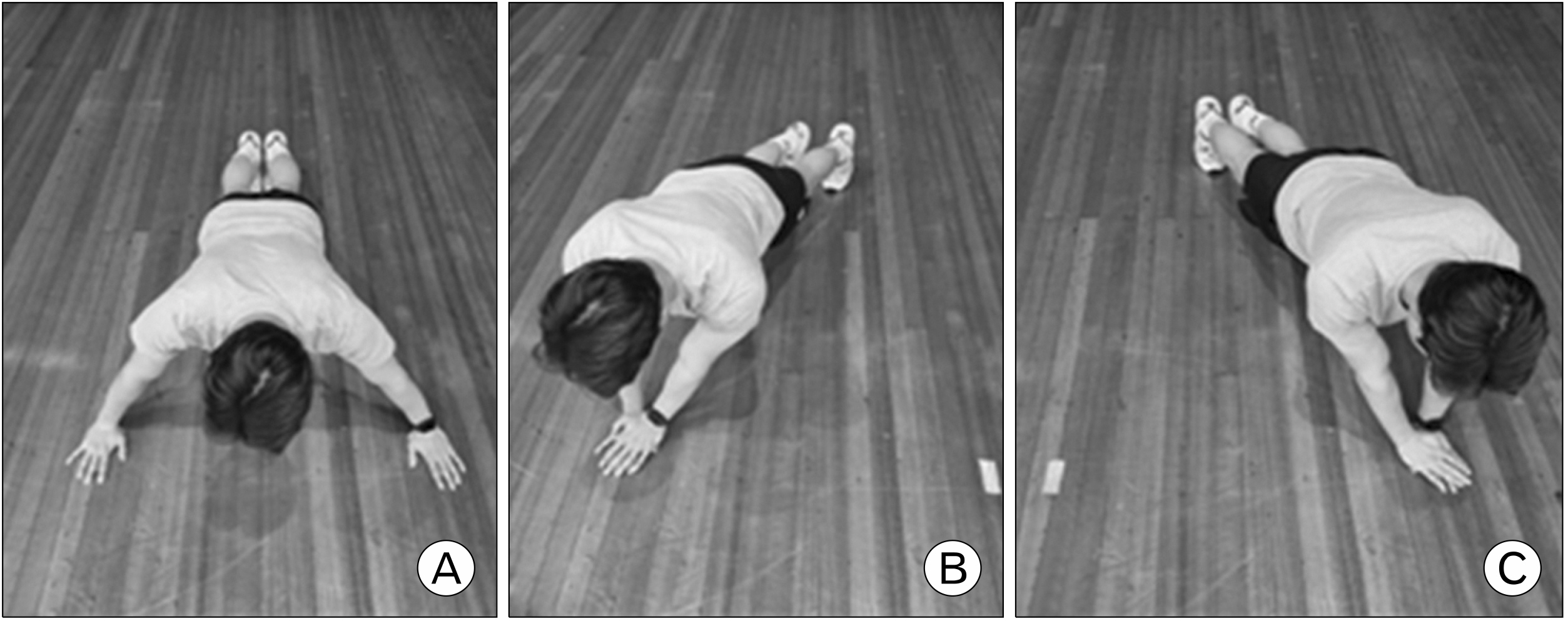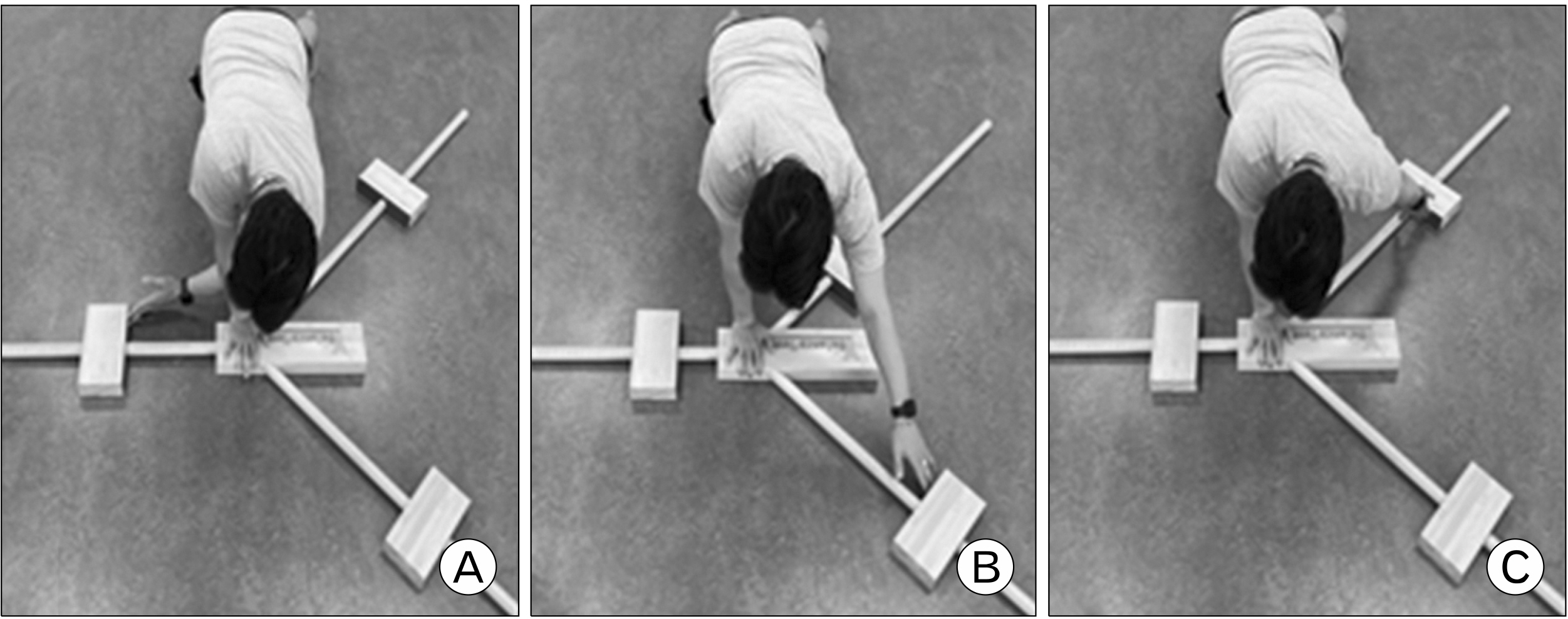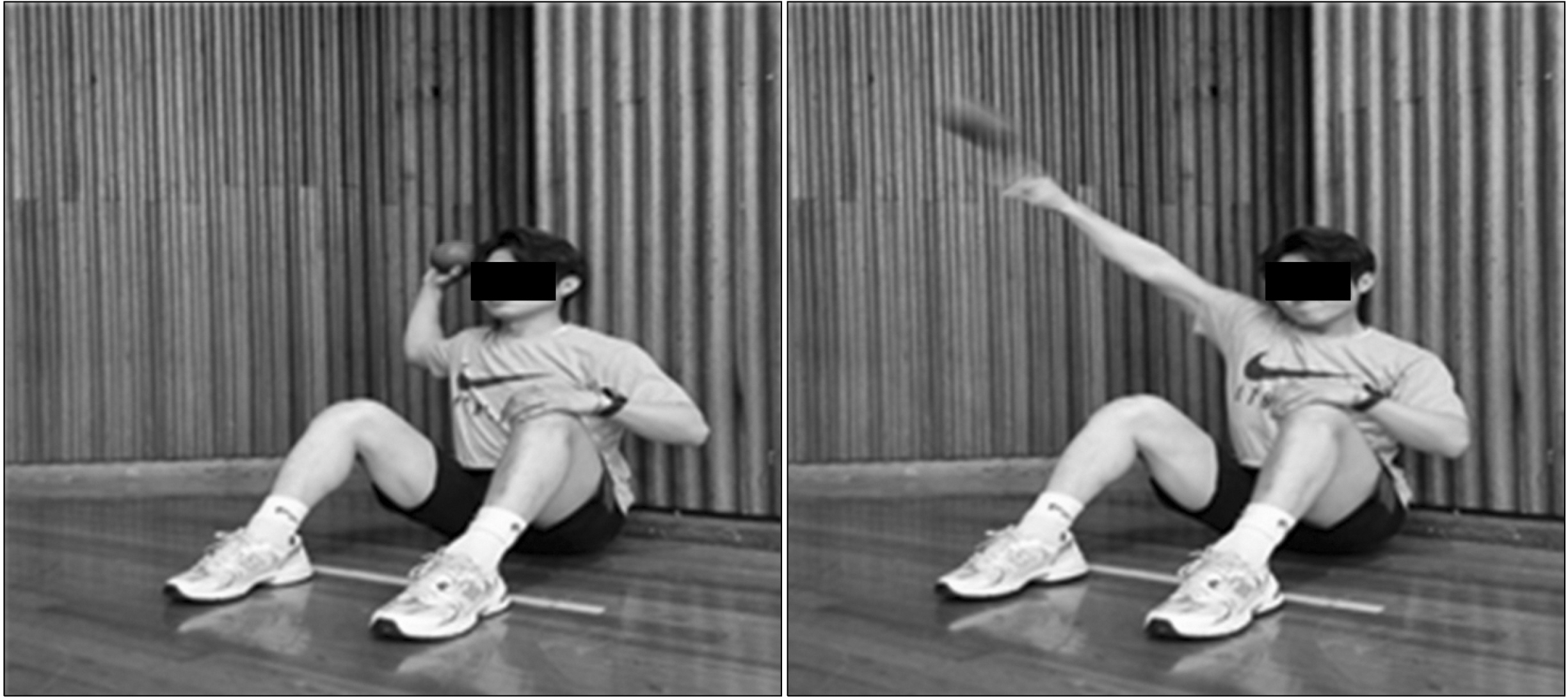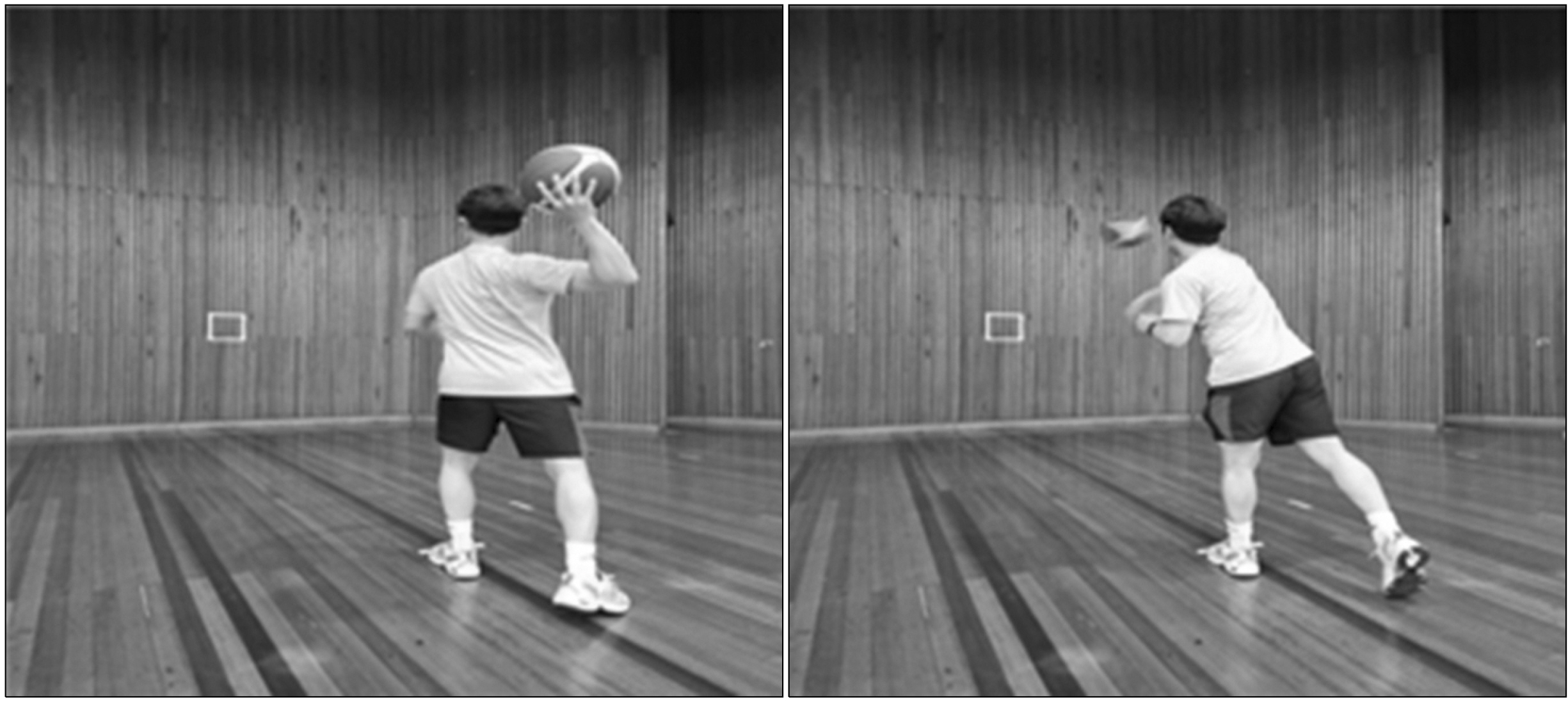Korean J Sports Med.
2024 Dec;42(4):270-279. 10.5763/kjsm.2024.42.4.270.
Effects of Plyometric Training and Resistance Training on Shoulder Proprioception and Neuromuscular Control in Overhead Sports Club Members
- Affiliations
-
- 1Department of Smart Healthcare Marine Sports Major, Pukyong National University, Busan, Korea
- KMID: 2561755
- DOI: http://doi.org/10.5763/kjsm.2024.42.4.270
Abstract
- Purpose
The purpose of this study was to investigate the effects of 6 weeks of plyometric training and resistance training on shoulder proprioception and neuromuscular control in overhead sports club members.
Methods
Twenty overhead sports club members participated in this program (male=14, female=6) who regularly participated in overhead sports activities were randomly assigned to a plyometric training group (n=10) and a resistance training group (n=10). The training program consists of 12 types of plyometric exercises and seven types of resistance exercises and it was conducted with the general overhead sports club activities for 6 weeks. Shoulder proprioception through joint position sense (JPS), threshold to detect passive motion (TTDPM) and neuromuscular control through closed kinetic chain upper extremity stability test (CKCUEST), upper quarter Y-balance test (UQYBT), seated medicine ball throw (SMBT), functional throwing performance index (FTPI) were measured before and after training.
Results
JPS external rotation (ER), CKCUEST normalization and CKCUEST power, UQYBT, FTPI were significantly improved in both groups after the 6-week training program. Also, TTDPM internal rotation, TTDPM ER, SMBT were significantly improved only in the plyometric training group.
Conclusion
The conclusion of this study is that both plyometric training and resistance training were shown to be effective in improving proprioception and neuromuscular control, but only plyometric training showed significant improvements in TTDPM and SMBT. Therefore, both trainings were effective in improving JPS ER, CKCUEST, UQYBT and FTPI, but only plyometric training was effective in improving TTDPM and SMBT.
Figure
Reference
-
1. Boudreau SL, Mattes LL, Lowenstein NA, Matzkin EG, Wilcox RB 3rd. 2022; Customizing functional rehabilitation and return to sport in the female overhead athlete. Arthrosc Sports Med Rehabil. 4:e271–85. DOI: 10.1016/j.asmr.2021.09.041. PMID: 35141561. PMCID: PMC8811549.2. Wilk KE, Meister K, Andrews JR. 2002; Current concepts in the rehabilitation of the overhead throwing athlete. Am J Sports Med. 30:136–51. DOI: 10.1177/03635465020300011201. PMID: 11799012.3. Jung HY. 2013; A study on the injury types of shoulder joints through MRI analysis in volleyball club members. J Sport Leis Stud. 51:657–65. DOI: 10.51979/KSSLS.2013.02.51.657.4. Plate JF, Haubruck P, Walters J, et al. 2013; Rotator cuff injuries in professional and recreational athletes. J Surg Orthop Adv. 22:134–42. DOI: 10.3113/JSOA.2013.0134. PMID: 23628566.5. Kang S, Kim K. Comparison of shoulder neuromuscular control in overhead athletes with and without shoulder hypermobility. Exerc Sci. 2020; 29:316–23. DOI: 10.15857/ksep.2020.29.3.316.6. Myers JB, Wassinger CA, Lephart SM. 2006; Sensorimotor contribution to shoulder stability: effect of injury and rehabilitation. Man Ther. 11:197–201. DOI: 10.1016/j.math.2006.04.002. PMID: 16777465.7. Myers JB, Lephart SM. 2000; The role of the sensorimotor system in the athletic shoulder. J Athl Train. 35:351–63.8. Myers JB, Oyama S. 2008; Sensorimotor factors affecting outcome following shoulder injury. Clin Sports Med. 27:481–90. DOI: 10.1016/j.csm.2008.03.005. PMID: 18503879.9. Kaya D, Callaghan MJ, Dönmez G, Doral MN. 2012; Shoulder joint position sense is negatively correlated with free-throw percentage in professional basketball players. Isokinet Exerc Sci. 20:189–96. DOI: 10.3233/IES-2012-0458.10. Swanik KA, Lephart SM, Swanik CB, Lephart SP, Stone DA, Fu FH. 2002; The effects of shoulder plyometric training on proprioception and selected muscle performance characteristics. J Shoulder Elbow Surg. 11:579–86. DOI: 10.1067/mse.2002.127303. PMID: 12469083.11. Lust KR, Sandrey MA, Bulger SM, Wilder N. 2009; The effects of 6-week training programs on throwing accuracy, proprioception, and core endurance in baseball. J Sport Rehabil. 18:407–26. DOI: 10.1123/jsr.18.3.407. PMID: 19827504.12. Salles JI, Velasques B, Cossich V, et al. 2015; Strength training and shoulder proprioception. J Athl Train. 50:277–80. DOI: 10.4085/1062-6050-49.3.84. PMID: 25594912. PMCID: PMC4477923.13. Gokalp O, Kirmizigil B. 2020; Effects of Thrower's Ten exercises on upper extremity performance: a randomized controlled study. Medicine (Baltimore). 99:e22837. DOI: 10.1097/MD.0000000000022837. PMID: 33080765. PMCID: PMC7571874.14. Davies G, Riemann BL, Manske R. 2015; Current concepts of plyometric exercise. Int J Sports Phys Ther. 10:760–86.15. Gómez-Bruton A, Matute-Llorente Á, González-Agüero A, Casajús JA, Vicente-Rodríguez G. 2017; Plyometric exercise and bone health in children and adolescents: a systematic review. World J Pediatr. 13:112–21. DOI: 10.1007/s12519-016-0076-0. PMID: 28101776.16. Vetrovsky T, Steffl M, Stastny P, Tufano JJ. 2019; The efficacy and safety of lower-limb plyometric training in older adults: a systematic review. Sports Med. 49:113–31. DOI: 10.1007/s40279-018-1018-x. PMID: 30387072. PMCID: PMC6349785.17. Vargas VZ, Motta C, Vancini RL, Andrade MS. Barbosa de Lira CA. 2021; Shoulder isokinetic strength balance ratio in overhead athletes: a cross-sectional study. Int J Sports Phys Ther. 16:827–34. DOI: 10.26603/001c.22162. PMID: 34123534. PMCID: PMC8169013.18. De Mey K, Danneels L, Cagnie B, Cools AM. 2012; Scapular muscle rehabilitation exercises in overhead athletes with impingement symptoms: effect of a 6-week training program on muscle recruitment and functional outcome. Am J Sports Med. 40:1906–15. DOI: 10.1177/0363546512453297. PMID: 22785606.19. Ager AL, Roy JS, Roos M, Belley AF, Cools A, Hébert LJ. 2017; Shoulder proprioception: how is it measured and is it reliable?: a systematic review. J Hand Ther. 30:221–31. DOI: 10.1016/j.jht.2017.05.003. PMID: 28641738.20. Lee HM, Liau JJ, Cheng CK, Tan CM, Shih JT. 2003; Evaluation of shoulder proprioception following muscle fatigue. Clin Biomech (Bristol, Avon). 18:843–7. DOI: 10.1016/S0268-0033(03)00151-7.21. Zarei M, Eshghi S, Hosseinzadeh M. 2021; The effect of a shoulder injury prevention programme on proprioception and dynamic stability of young volleyball players; a randomized controlled trial. BMC Sports Sci Med Rehabil. 13:71. DOI: 10.1186/s13102-021-00300-5. PMID: 34193267. PMCID: PMC8246688.22. Tucci HT, Martins J, Sposito Gde C, Camarini PM, de Oliveira AS. 2014; Closed Kinetic Chain Upper Extremity Stability test (CKCUES test): a reliability study in persons with and without shoulder impingement syndrome. BMC Musculoskelet Disord. 15:1. DOI: 10.1186/1471-2474-15-1. PMID: 24387196. PMCID: PMC3890535.23. Ellenbecker TS, Manske R, Davies GJ. 2000; Closed kinetic chain testing techniques of the upper extremities. Orthop Phys Ther Clin N Am. 9:219–30.24. Ferreira LG, de Oliveira AS, do Carmo ND, et al. 2021; Reliability and validity of the One Arm Hop Test and Seated Medicine Ball Throw Test in young adults: a cross-sectional study. J Bodyw Mov Ther. 28:26–33. DOI: 10.1016/j.jbmt.2021.07.018. PMID: 34776150.25. Wassinger CA, Sole G, Osborne H. 2012; The role of experimentally-induced subacromial pain on shoulder strength and throwing accuracy. Man Ther. 17:411–5. DOI: 10.1016/j.math.2012.03.008. PMID: 22503543.26. Pretz R. 2004; "Ballistic six" plyometric training for the overhead throwing athlete. Strength Cond J. 26:62–6. DOI: 10.1519/00126548-200412000-00014.27. Kraemer WJ, Adams K, Cafarelli E, et al. 2002; American College of Sports Medicine position stand: progression models in resistance training for healthy adults. Med Sci Sports Exerc. 34:364–80. DOI: 10.1097/00005768-200202000-00027. PMID: 11828249.28. Torres R, Duarte JA, Cabri JM. 2012; An acute bout of quadriceps muscle stretching has no influence on knee joint proprioception. J Hum Kinet. 34:33–9. DOI: 10.2478/v10078-012-0061-1. PMID: 23486744. PMCID: PMC3590824.29. Riemann BL, Lephart SM. 2002; The sensorimotor system, part I: the physiologic basis of functional joint stability. J Athl Train. 37:71–9.
- Full Text Links
- Actions
-
Cited
- CITED
-
- Close
- Share
- Similar articles
-
- Effects of 6-Week Dynamic and Static Neuromuscular Training Program on Postural Stability Control of High School Taekwondo Athletes
- Perception of Balance Training and Evaluation
- Effects of Plyometric Training on Ankle Joint Motion and Jump Performance
- Microinstability of the Shoulder
- Scapular Dyskinesis

